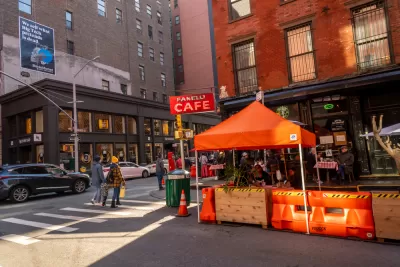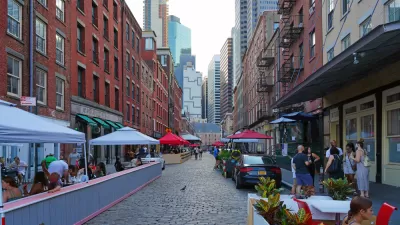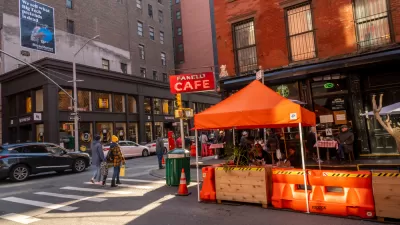New York City's Open Restaurants Program, while here to stay, is going to see substantial changes, requiring new permits, as soon as next year.

"Outdoor sheds, igloos and heated cabanas — hallmarks of New York City’s pandemic-era restaurant scene — may soon be a thing of the past," write Alicia Diaz and Kate Krader in the provocative lede to a Bloomberg CityLab story about the future of New York City's outdoor dining program.
While the city declared its outdoor dining program, known as the Open Restaurants Program, permanent back in September 2020, the city is still searching for a balance after "complaints over trash, rats, noise and fewer parking spaces have incited a push for a more regulated approach to the outdoor structures," according to Diaz and Krader.
Now, the city wants to move away from the permanent encampments of shipping containers or plywood shacks with sliding doors and heating systems, potentially toward a more European streetscape of bistro tables and colorful umbrellas that can be removed at closing time. The idea is to find a compromise between cultivating a vibrant hospitality industry, while keeping residents happy.
Changes could be coming in 2023, according to the article. "[T]he City Council envisions a permanent program that would expand access to sidewalk dining and allow many of the businesses approved under the pandemic emergency measures included in the original Open Restaurants Program to reapply for permits, according to a zoning amendment approved in February," according to the article.
More details on the political and economic debate about the city's outdoor dining program are included in the source article below.
FULL STORY: Inside the Fight Over the Future of New York City’s Outdoor Dining

Planetizen Federal Action Tracker
A weekly monitor of how Trump’s orders and actions are impacting planners and planning in America.

Congressman Proposes Bill to Rename DC Metro “Trump Train”
The Make Autorail Great Again Act would withhold federal funding to the system until the Washington Metropolitan Area Transit Authority (WMATA), rebrands as the Washington Metropolitan Authority for Greater Access (WMAGA).

The Simple Legislative Tool Transforming Vacant Downtowns
In California, Michigan and Georgia, an easy win is bringing dollars — and delight — back to city centers.

The States Losing Rural Delivery Rooms at an Alarming Pace
In some states, as few as 9% of rural hospitals still deliver babies. As a result, rising pre-term births, no adequate pre-term care and "harrowing" close calls are a growing reality.

The Small South Asian Republic Going all in on EVs
Thanks to one simple policy change less than five years ago, 65% of new cars in this Himalayan country are now electric.

DC Backpedals on Bike Lane Protection, Swaps Barriers for Paint
Citing aesthetic concerns, the city is removing the concrete barriers and flexposts that once separated Arizona Avenue cyclists from motor vehicles.
Urban Design for Planners 1: Software Tools
This six-course series explores essential urban design concepts using open source software and equips planners with the tools they need to participate fully in the urban design process.
Planning for Universal Design
Learn the tools for implementing Universal Design in planning regulations.
Smith Gee Studio
City of Charlotte
City of Camden Redevelopment Agency
City of Astoria
Transportation Research & Education Center (TREC) at Portland State University
US High Speed Rail Association
City of Camden Redevelopment Agency
Municipality of Princeton (NJ)




























